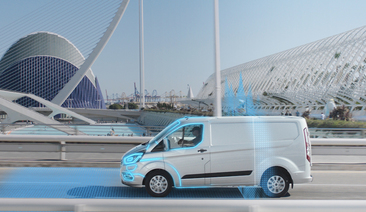News

Ford Introduces Automatic Electric Mode
Awareness of how air quality can affect our health is driving cities, companies and individuals to find ways to reduce emissions and take responsibility for their environmental impact.
Technology being introduced by Ford aims to promote cleaner air where it is needed most by ensuring its new breed of plug-in hybrid commercial vehicles operate in zero-emission electric‑only drive mode in sensitive areas.
Using live location data, the Transit Custom Plug-In Hybrid electric (PHEV) vans will automatically switch to electric drive mode whenever they enter predefined areas such as congestion and low‑emission zones, helping to keep air clean on city streets. *
However, this geofencing tech doesn’t only apply to city centres: vehicle operators can also create custom “green zones” to encourage low-emission driving around locations such as schools, playgrounds and warehouses.
And, when the vehicle leaves a controlled zone, it can automatically switch to the most appropriate drive mode to complete the next leg of the journey – for example, engaging the onboard EcoBoost petrol engine to generate electric power and extend the vehicle’s range.
Hybrid electric drive
The Transit Custom Plug-In Hybrid van and Tourneo Custom Plug-In Hybrid people mover are the first vehicles in their class to offer a plug-in hybrid option. A 13.6 kWh battery helps to deliver a zero-emission NEDC driving range of up to 56 km (35 miles) NEDC for the Transit Custom PHEV, and up to 53 km (33 miles) NEDC in the Tourneo Custom PHEV. In both vehicles the onboard 1.0-litre EcoBoost petrol engine can charge the battery on-demand to extend their range to more than 500 km (310 miles) NEDC. **
Both vehicles can be fully recharged in under four-and-a-half hours from a standard domestic mains supply, or in under three hours using commercial charging point. *** Further electrical energy is captured through regenerative braking when the vehicle decelerates or brakes. Ford Transit Custom Plug-In Hybrid and Tourneo Custom Plug-In Hybrid entered volume production in late 2019.
Trials by Ford across Europe have shown how PHEVs offer a practical every-day solution for van owners and businesses working in the city, enabling them to complete longer journeys when required. As the vehicles aren’t reliant on charging infrastructure there is no range or charge anxiety, meaning they can deliver the best of both worlds: zero-emission driving capability with no compromise on getting the job done. There is no reduction in payload or load volume compared with a conventional diesel model.
Quotes
“Improving the quality of air – and quality of life – in our towns and cities is a goal that we all have a responsibility to drive towards. The Transit Custom Plug-In Hybrid and its new geofencing feature helps our customers to make a real contribution to that goal without compromising on efficiency or productivity.”
Mark Harvey, director, Commercial Vehicle Mobility, Ford of Europe
You can see the video about this story here.
* Geofencing module introduced from autumn 2020 and will be available from autumn to retrofit to vehicles produced earlier. The vehicle will engage its electric drive mode when entering a geofence zone only if there is sufficient charge in the battery.
** Transit Custom Plug-In Hybrid CO2 emissions from 60 g/km and fuel efficiency from 2.7 l/100 km NEDC (70 g/km and fuel efficiency from 3.08 l/100 km WLTP); Tourneo Custom Plug-In Hybrid CO2 emissions from 70 g/km and fuel efficiency from 3.1 l/100 km NEDC (81 g/km and fuel efficiency from 3.57 l/100 km WLTP).
*** Fully charged from a standard 240-volt 10-amp mains supply in 4 hours 20 minutes, or in 2 hours 45 minutes using a commercial type-2 16-amp AC charger.
The declared fuel/energy consumptions, CO2 emissions and electric range are determined according to the technical requirements and specifications of the European Regulations (EC) 715/2007 and (EU) 2017/1151 as last amended. Light Duty Vehicle type-approved using the World Harmonised Light Vehicle Test Procedure (WLTP) will have fuel/energy consumption and CO2-emission information for New European Drive Cycle (NEDC) and WLTP. WLTP will fully replace the NEDC latest by the end of the year 2020. The applied standard test procedures enable comparison between different vehicle types and different manufacturers. During NEDC phase-out, WLTP fuel consumption and CO2 emissions are being correlated back to NEDC. There will be some variance to the previous fuel economy and emissions as some elements of the tests have altered, so the same car might have different fuel consumption and CO2 emissions.